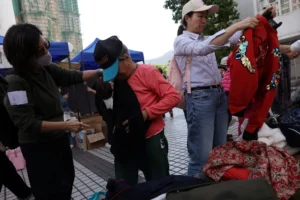
This year, Shanghai launched a system of traffic safety codes which “aggregates records of traffic accidents and violations involving couriers throughout the city, [and] allows the authorities to identify non-compliant enterprises, accident-prone service points, and high-risk riders, enabling targeted enforcement.” The deployment follows earlier moves such as the city’s introduction of license plates with tracking chips for some platforms’ couriers in June 2023. As the recently shuttered labor NGO China Labour Bulletin noted at the time, “Other drivers on the road are not subject to the electronic chip plates or the automatic fine system, meaning that these precarious workers face a type of legal discrimination on the basis of their work [….] In practice, the monitoring system places riders in a Catch-22: Either be fined by the platform company for late deliveries, or be fined by the traffic bureau for unsafe driving. […] Shanghai’s new special operation only highlights how burdens are shifted onto the shoulders of workers alone.”
Safety codes for delivery drivers trigger PTSD for Shanghai residents
The sky over Shanghai is blue, but the code on the delivery guy’s phone screen is red.
Yes, you read that right: red and green codes are back.
This time, they’re not about COVID controls, but about “traffic safety.”
Still, as soon as they appeared, the whole city experienced a flashback:
“Is this another experiment in ‘behavioral governance?’”
This time the test subjects aren’t the city’s collective citizenry, but those blue-uniformed delivery guys who race against the wind on their e-bikes to fulfill orders.
Not traffic safety, but data slavery
Shanghai traffic police teamed up with delivery platforms to launch the so-called “traffic safety codes” in June of 2025.
Each delivery worker is assigned a personal QR code.
In real time, the system tracks whether you’re running red lights, going against traffic, ignoring road markings, exceeding the speed limit, making phone calls, or not wearing a helmet.
Then it gives you a score. If it’s too low, you could lose orders, get a lower ranking, or even be dropped from the platform.
A high score “rewards” you with the privilege of continuing to work yourself to death, egged on by priority assignments and cash bonuses.
Sounds eminently “scientific” and “rational,” doesn’t it?
So “rational” that it sends a shiver down your spine.
Behind every “red code” violation, there’s a human being too overworked to explain
You ask why he ran that red light?
How could he afford not to?
Here’s the system he’s up against:
A clock that won’t stop once it’s started
Rules that state “late deliveries mean complaints, and complaints mean fines”
Requests like “Just bring it upstairs and leave it at the door, thanks” that don’t leave a second to spare.
The result is that the platforms push them to go quicker while also accusing them of rule-breaking.
Now it’s even better. Break the rules? Get a red code.
Don’t break the rules? Your reward is more orders, making it more likely that you’ll break the rules in future.
This isn’t safety management: it’s a digital cage.
With red and green codes still fresh in their memories, Shanghaiers are dragged back into “surveillance court”
Anyone from Shanghai feels their heart skip a beat when they hear the words “red code” or “green code.”
We’re all too familiar with them.
From 2020 on, we all lived by that color code:
Red, yellow, or green controlled where you could go, what you could do, who you could meet, even whether or not you deserved food.
Now, it’s even better: the colors aren’t regulating a virus, but your very humanity.
You sort the working masses into “risk categories,” and use algorithms to strip away their rights
It’s not that delivery guys ignore the rules; it’s that they’re not allowed them.
You say he ran red lights, but you forced him to deliver five orders across three kilometres in ten minutes.
You say he drove against one-way traffic, but you don’t give him a legally feasible route plan.
You say he didn’t wear a helmet, but you don’t give him the chance to explain a delay of the 30 seconds it would take him to put it on.
It’s not that he doesn’t want to slow down, it’s that this system doesn’t give him the right to stop for a moment to catch his breath.
And now, even a single wrongful complaint could lead to a red code, lost points, and a ban.
No hearing, no discussion, no appeal …
Just a QR code coldly deciding whether he can afford to eat tonight. [Chinese]





